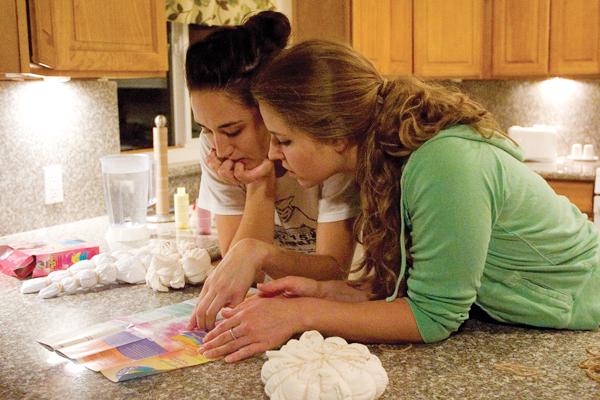Tie-dye on campus

The State Hornet
Senior photography major Ashley Knight (right) and friend Allison Arai (left) prepare for their traditional tie-dye night on Oct. 20. :
November 5, 2008
For many Sacramento State students, Tuesdays on campus are just like any other day. For senior photography major Ashley Knight, her brother and a few loyal friends, Tuesdays are for tie-dye.
Every Tuesday, a couple of students donning the crazy, colorful shirts can be spotted, thanks to Knight’s encouragement and her fliers posted around campus.
The idea behind tie-dye Tuesday started when Knight realized she and her brother were signed up for the same class.
“We decided it would be really hilarious to show up wearing matching outfits, (but) we were kidding; it was a joke,” Knight said. “We went to the bookstore and got ourselves some matching Sac State booty shorts and decided we should make shirts to go with it, which turned into ‘We should make tie-dye shirts to go with this.'”
Now, while some may search for a deeper meaning to tie-dye Tuesday, Knight and her friend Allyson Arai, a receptionist in Lassen Hall, started this weekly event just to do something a little different to have some fun and enjoy colorful clothing. As the semester wore on, they realized how they wanted to spread the colorful cheer to the masses.
Though Knight’s idea may be somewhat original to Sac State, tie-dye has a long and storied history well past the days of the hippies and peace lovers of the ’60s. According to harmonytie-dies.com, tie-dying reaches all the way back to the Tang Dynasty of China, which lasted from 608 to 906 A.D.
In those times, fabrics such as silk and hemp, which are very receptive to the most commonly used dying process known as the “resist technique,” were used. The technique is accomplished by binding certain parts of the material with various instruments like rubber bands, wax and even stitching to keep the dye from being absorbed and creating the tie-dye effect. Dies were often made by extracting the colors out of roots, flowers, leaves and berries.
To those who have not attempted to make tie-dye before, the task may seem daunting, but most of the time, ready-to-use kits can be found at retail stores, such as Wal-Mart or Target.
Another of Knight’s friends and fellow tie-dyer Katie Schostag explains the difficulty with modern fabrics.
“There is this chemical that they put on the shirts while they are making them and that makes the dye come out after washing them,” Schostag said.
Knight and Arai challenge this by dying directly out of the bag, being sure to rub the dye into the material to resolve the fresh fabric dilemma. The rest of the process involves setting the newly-dyed clothes into plastic bags, ideally letting them set overnight. Once they have sat long enough and the dye has had a chance to set in, a cold, soapless rinse is performed in the washer, or as Arai prefers, in a bucket of cold water.
Knight said her enthusiasm for tie-dye reaches back to an earlier time in her life.
“We went to Mission Avenue Elementary School and did a lot of tie-dye there. I’m not sure why, but we tie-dyed a lot; it was for trips and stuff. We tie-dyed our shirts for all the little random trips we went on,” Knight said.
Arai said she came on board to the tie-dye “grassroots movement” with little persuasion by Knight.
“We were just hanging out having coffee one day and she was telling me about it. I thought it was hilarious and said we should totally do it. From then it was sort of born,” Arai said.
Rewind to the first day of school, with Knight and her brother sporting tie-dye shirts and the Sac State booty shorts, the movement started with more of a whisper than a boom.
In the following weeks after plastering promotional posters all over campus, some people started to recognize the significance of the tie-dye with its appropriate day.
“We didn’t get that much of a reaction; people just thought we were wearing tie-dye. Since then I have had people say, ‘Oh are you doing tie-dye Tuesday?’ Because they saw the posters,” Knight said.
Arai had her own tie-dye recognition at one of the many on-campus eateries.
“I had the guy (at) the Java City Roundhouse be like, ‘Oh cool, you went with the rule; you’re obeying the signs.’ I was like, ‘Actually, my friend and I started it,'” Arai said.
Although the creation of tie-dye Tuesday was born more out of a random thought than careful planning, Knight and Arai have plans to try to keep this weekly event strong.
“Our short term goal is just to get as many people involved as possible because it’s just a fun thing that has no purpose. It’s just a silly thing to do,” Knight said.
Knight said they plan on having an Election Day raffle to auction off several custom made red, white and blue tie-dye shirts. The raffle is an attempt to encourage Sac State students to vote, and of course to wear tie-dye on Tuesdays.
Knight and her fellow tie-dyers have at least one long term goal that Arai said she especially hopes to accomplish before she has moved on from Sac State. A goal that, much like the rest of tie-dye Tuesday, has no real purpose or meaning but is just meant for everyone to have a little more fun and color in their lives.
“We would eventually like to get a V.W. bus and just drive it around campus and have free tie-dye inside,” Arai said.
Matt Rascher can be reached at [email protected]












































































































































